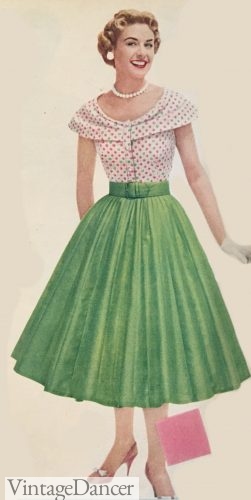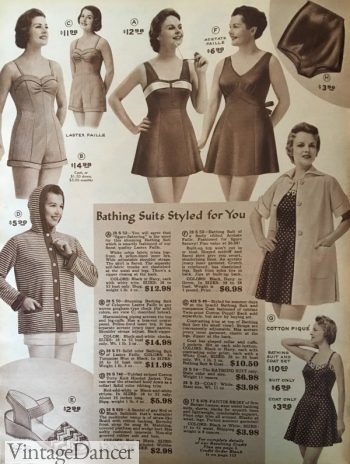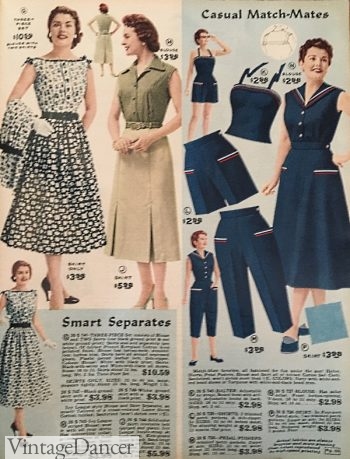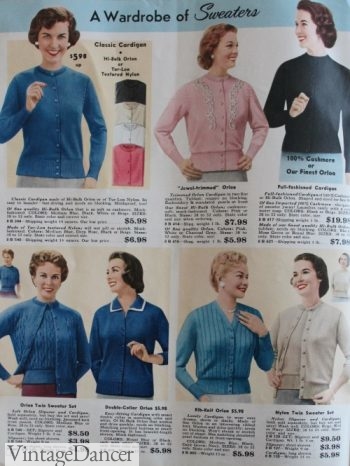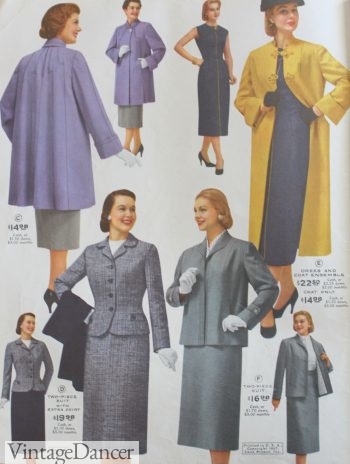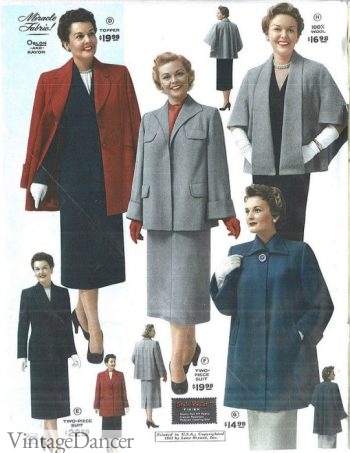
Vintage plus size fashions in the past have not always been gracious to the fuller figure, but the forties and the fifties brought on a silhouette that was both flattering and attractive for the wearer. From juniors to misses, women’s and stout (as plus size clothing was called) clothing was available to fit and flatter all bodies. For the first time, 1950s plus size fashion came in the same styles as ladies’ fashion did. 1950s dress styles were very flattering to the full-figured woman.
** Note: Plus size today and plus size in the 1950s are not one in the same. 1950s plus sizes started at a modern size 10/12. The models in these catalogs don’t look “plus” to our modern eyes, but in the 1950s they would have been considered such. Plus sizes had more to do with shape rather than measurement, which is why “stout” was a better description back then.
Skip the history and shop 1950s plus size dresses and reproduction clothing.
1950s Plus Size Fashion History
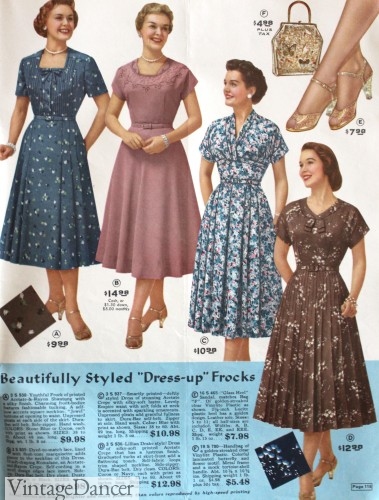
1950s Dress for Plus Sizes
As recommended for every girl, dressing for your figure, your complexion, and your preferences are all factors when it comes to style and what to wear.
Carolyn Zucker recalls her process of dressing in undergarments as a young woman in the fifties. “Reorganization of the body was necessary and began with the many-boned Merry Widow to hold the midriff in and push up the bosom. To keep tummy and thighs from bulging, the elasticized girdle extended from the waist to approximately five inches above the knees.”
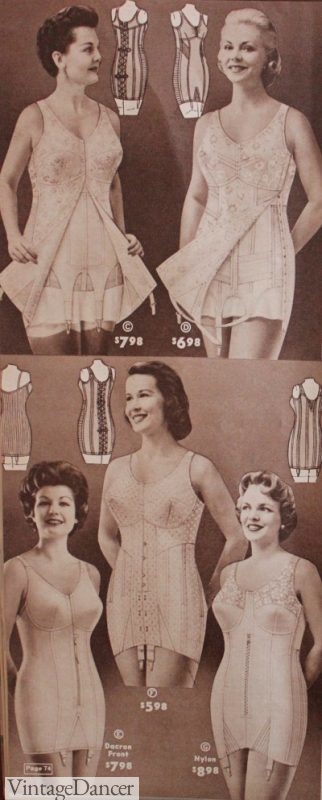
1950s Corsets for the Full Figured Woman
The best way to make sure your clothes fit well is to have the proper undergarments. So, be sure to keep in mind the styles you’re achieving and what undergarments can help. A padded, pointed bra (bullet bra) or longline bra and a modern waist cincher can do wonders to the figure and are easy to find at stores. A petticoat will help greatly with full skirts, and a slip is essential with all form fitting dresses. These undergarments are no different than the requirements for standard ladies’ sizes.
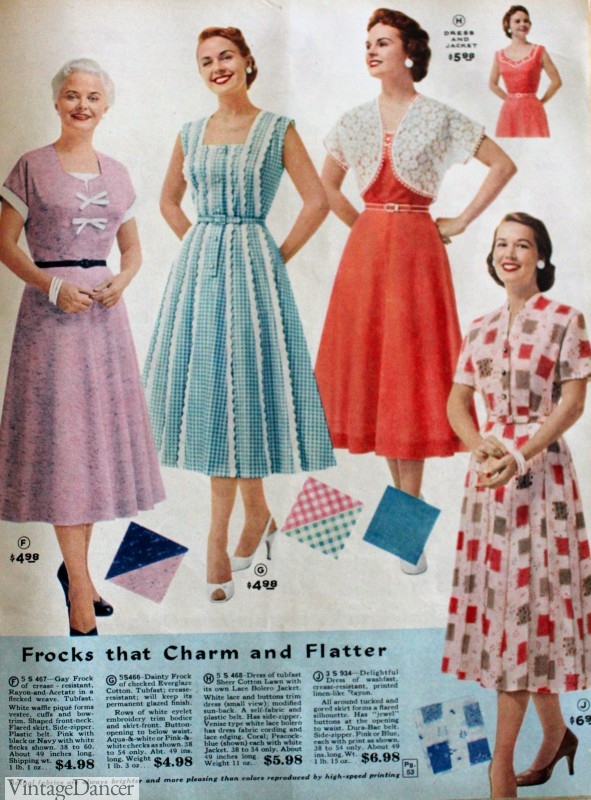
Full Skirts and Bodice Tops with Short or Sleeveless Lengths are Flattering
Dior’s “New Shape” was all the rage for women regardless of size. Women of all figures were out to achieve the hourglass figure, and Merry Widow corsets were all the rage. They were symbols of womanhood and were iron corsets that hampered movement, breathing and eating. But all of these things came secondary to the fashion demands of the decade.
1950s Plus Size Fashion: Colors and Patterns
Navy, black, dark red, forest green, and browns are dark slimming colors that often flatter a fuller figure. Spring colors in pink, blue and purple are ideal, too. Skirts with long pleats down the front will add vertical lines, which are also very slimming. However, if you’re looking for something more fun, dresses with prints or stripes or repeating florals are flattering on any body shape. 1950s dresses were often belted or cinched at the waist to achieve that hourglass look.
The amount of contrast between dark and light colors in an outfit is important when it comes to distributing weight and complementing the parts of our bodies that we want to emphasize. Breaking the body apart into smaller sections will also help with looking proportionate.
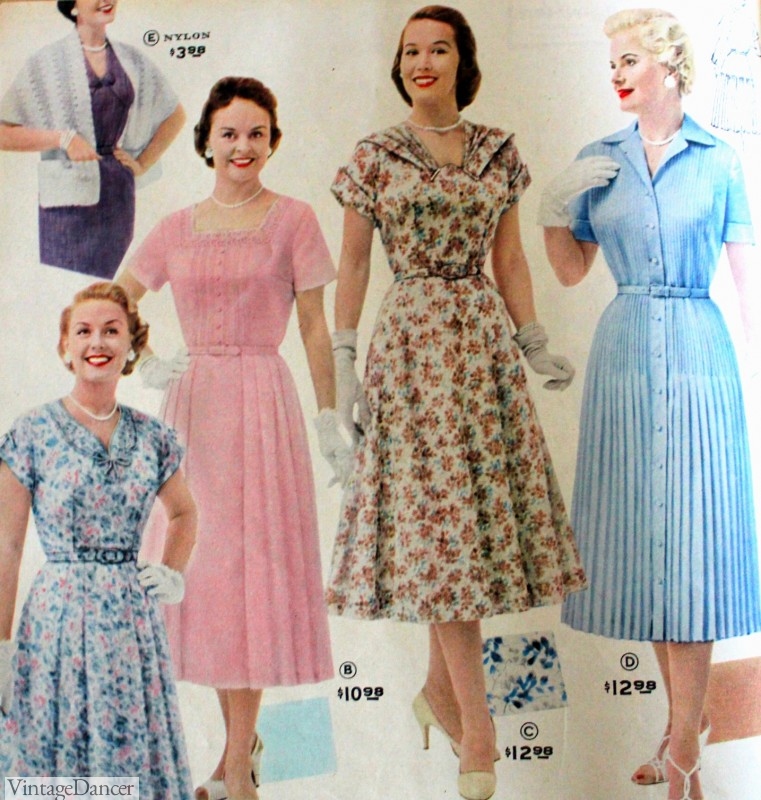
Tea Length Dresses in Spring Colors
1950s plus size dresses and skirts were typically tea-length and could be tank style, cap sleeve, short sleeve, or full length. Necklines were very modest, and dresses were often embellished with nice buttons or playful necklines with bows or scalloped edges.
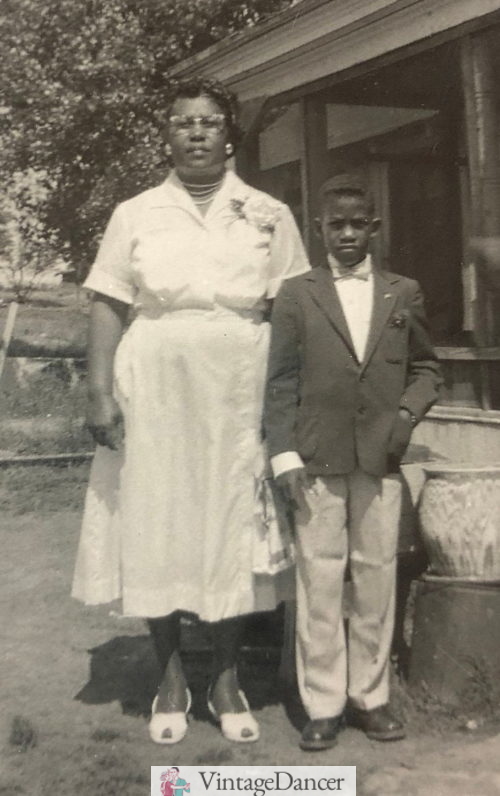
Dressed in Sunday clothes, a lovely white shirtwaist tea dress
Never underestimate the importance of texture when it comes to clothing. Making sure the material hangs well on your body is important second to none. Fabrics that are flimsy, stiff, bulky, or shiny are a no-go.
Things like stretch pants or leotards were sometimes worn to shape to the contour of the body. They were also comfortable, not bulky, provided warmth, and were easy to care for.
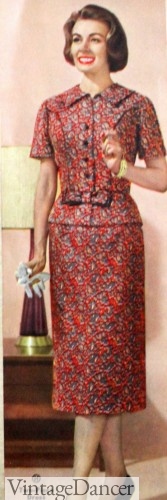
wool Pencil Dress
Along with the Dior “New Shape” silhouette, the wiggle dress and pencil skirt is are classic looks that are as timeless as can be. Similar to a dress with a fuller skirt, a wiggle dress is cinched at the waist but hugs the hips and thighs, giving that sexy polished look.
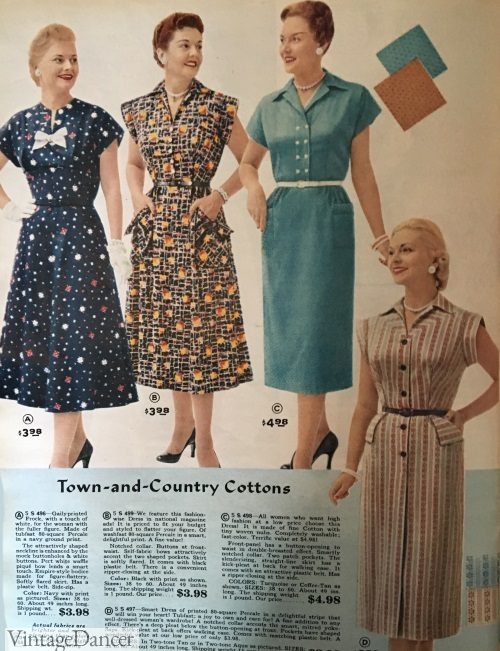
1957 pencil dresses and tea dresses
Lane Bryant, a New York designer, started offering clothing for “stout” women by mail order in 1909. Bryant tailored to her customers’ needs and gave them an air of “modish slenderness” regardless of her proportions. Women loved it. Her designs were applauded by mature women, too, who appreciated the less confining styles and modest coverage. Learn more about 1950s Mrs / Mature women’s fashions.
- 1957 swing skirt and polka dot portrait collar top, plus size Lane Bryant
- 1957 swimsuits and rompers for plus size and mature women
- 1957 casual separates and summer playsuits
- 1959 Sweaters
- 1959 women’s suits and coats
- 1954 winter styles suits and coats
1950s Plus Size Clothing: Guidelines for the Short/Stout Figure
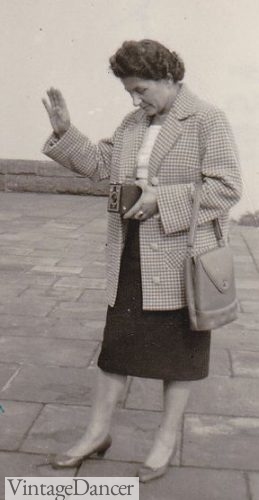
1950s woman in pencil skirt and coat
The following is an excerpt from a fashion and beauty advice book written in 1955. The advice is for plus size, short or tall, and how to choose clothing that flatters the wearer best. Rather than paraphrase, I think it is fascinating to read her direct words and interpret them as best we can today. My interpretation is in parentheses ( ) :
The Arts of Costumes and Personal Appearance by Grace Margaret Morton, 1955
1. Lines in continuous unbroken vertical movement, or upward- slanting diagonals. Very restrained curves will give added grace, whereas severe straight lines tend to emphasize rotundity. (Avoid horizontal stripes. Choose vertical or angled stripes and patterns as well as trim placement.)
2. Silhouettes which are graceful and flowing, of modified tubular versions, giving the impression of being draped on the figure. Easy, comfortable perfection of fit, because a fit too tight makes the figure appear larger. (Not too loose and not too tight. A dress that is just right will flatter the best. There is such thing as too tight, even in a wiggle dress.)
- a. Sleeves cut on the bias will give a slimming effect when carefully fitted. When extended to the wrist in easy fit or terminating several inches above the wrist, they tend to camouflage the size of a large forearm. Wide, loose sleeves tend to widen the figure. Heavy upper arms should never be entirely exposed in evening dress, but partially concealed by draped sleeves or a graceful stole. (Sleeves should fit not too tight and not too loose. Covering arms is a common practice for modern plus size gals, too. It’s ok! Finding repro dresses with sleeves is a challenge. Wearing a cardigan sweater or Bolero jacket over your dress is the easiest solution.)
- b. Bustlines may be designed with slightly draped fullness or ease, rather than being revealingly smooth and tight, or again, they may be broken by some vertical or diagonal movement. (Light layers or trim around the bust was a common look in the 1950s. It’s less common in repro clothing today.)
- c. Waistlines, usually thick in this figure, maybe minimized by some irregularity of line which does not definitely define the waistline, as by seamings or panels which carry the eye upward and outward at the shoulder and inward as it approaches the waistline. Half belts or narrow inconspicuous belts of self-material may be used. (A thin belt in a matching material or color does a lot of good in defining a waistline.)
- Skirts should be simple, easy, flowing in line, never tight and narrow, worn long enough to break the effect of heavy calves, always with some easy fullness at the bottom to give grace in walking and to balance the figure, cut straight at sides with center pleats or gores having low placed flare at front and back. The coat-style dress draws attention away from the broad outline of the silhouette and breaks up the width in vertical areas. (Pencil skirts are ok as long as they hang straight or flair a bit at the hem. Circle skirts are wonderful and flattering on all body shapes.)
- Coats may be full length, either straight or semi-fitted with easy loose-fitting sleeves. (Simple coats, not fussy. Learn more about 1950s style coats and jackets.)

A Shawl Collar Dress is Very Flattering for Plus Sizes
3. Spacing should be broken by long narrow verticals and upward slanting diagonals with emphasis always within the silhouette.
- a. Necklines should be cut close at the sides and back.
- b. Collars, if any, should be narrow and relatively flat. The shawl collar is one of the most flattering.
- e. Pockets may be placed high above the bustline to create the illusion of greater length below.
(Avoid small stripes, choose a square or oval neck shape, keep the skirt simple with embellishments just on top.)
4. Scale in accessories according to principle so that they apparently dwarf the figure, i.e., heavy jewelry, large flat bags, etc. All individual parts of the costume must be in scale with the size of the figure. (Choose accessories that are the right size in proportion to your body. Instead of a single strand of pearl add double or triple stands to stand out more.)
5. Values medium to dark in tone. Dull black has a receding effect. Close values in fabric combinations or in prints camouflage and obliterate lines. (Choose matte over shiny fabrics, dark solids or large prints.)
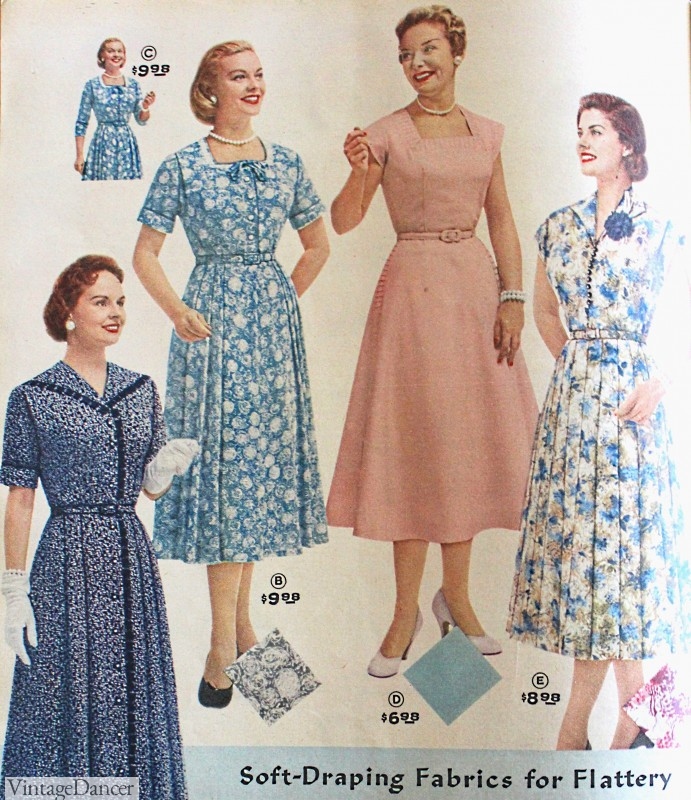
1950s Afternoon Dresses “Soft Draping Fabrics” that hang in defined folds.
6. Colors. Dark values which are soft and grayed in tone; cool hues and those that are cool-warm, depending on the degree of stoutness, complexion, and temperament. (Skin tone and hair color have a lot to do with choosing flattering colors, not just body shape.)
7. Texture. It is safe to say that no other factor equals in importance the nature of the texture for the heavy person. Without the right texture, the illusory impression resulting from suitable design is destroyed. With the right texture, one may sometimes find it possible to apply principles less rigidly.
One important rule is to buy only materials with the body; those which have a good fall, which hang in fairly heavy limp folds. Do not use fabrics which are flimsy or fluttery, bulky or wiry, or stiff or shiny. Materials which have substantial draping qualities are never inexpensive but in the end they pay in longer wear and good appearance to the last thread:
- a. Shiny or stiff textures increase the apparent size of the wearer and accent the silhouette; dull-surfaced textures decrease the size of the wearer and conceal the silhouette.
- b. Transparent fabrics are figure-revealing unless in several thicknesses. Opaque sheers cause figures to recede when in neutral tones and darker values.
- c. Heavy, wiry, or bulky fabrics add to apparent size; light weight, smooth textures tend to reduce bulk.
- (Most repro dresses are made of a heavy cotton blend, which works great on plus size figures. Avoid light and airy silk, satin, chiffon, voile or even rayon unless properly supported by slips and petticoats.)
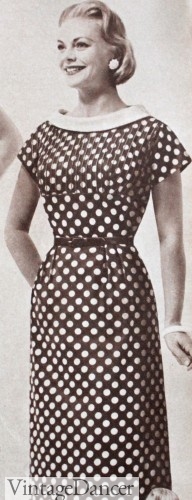
Large Polka Dots are very ’50s and very becoming
8. Prints that direct the eye in an up-and-down movement are slenderizing to short, stout people, if their values are close and they are compactly spaced, as in stripes or geometric designs. Prints that lead the eye in a circular or swirling movement suggest rotundity. Prints that are widely spaced and in strong contrast attract attention to size. (Choose small prints, not bold ones, and colors that are similar not contrasting. The exception might be a bold polka dot but a small dot print is more likely to look better)
9. Furs. Short-haired, flat skins. Never bushy, bulky or long-haired furs. (Not that we wear furs much today, but if you do, or any shawl or accessory around your neck, be sure it is thin, not bulky.)
1950s Plus Size Clothing: Guidelines for the Tall/Stout Woman
The tall, muscular, heavy-boned Nordic woman is another for whom the present fashions are not designed. Her problem is difficult in that she is too tall to resort to the vertical line direction best for the stout figures and too broad to emphasize the horizontal movement which reduces the height of the tall, thin, angular person. She must compromise with designs wherein are employed a balance of both horizontals and verticals, never the one without the other. She must also break up the
expansiveness of large surfaces into smaller areas. (Break up a vertical print with a medium or thick belt in a contrasting color.)
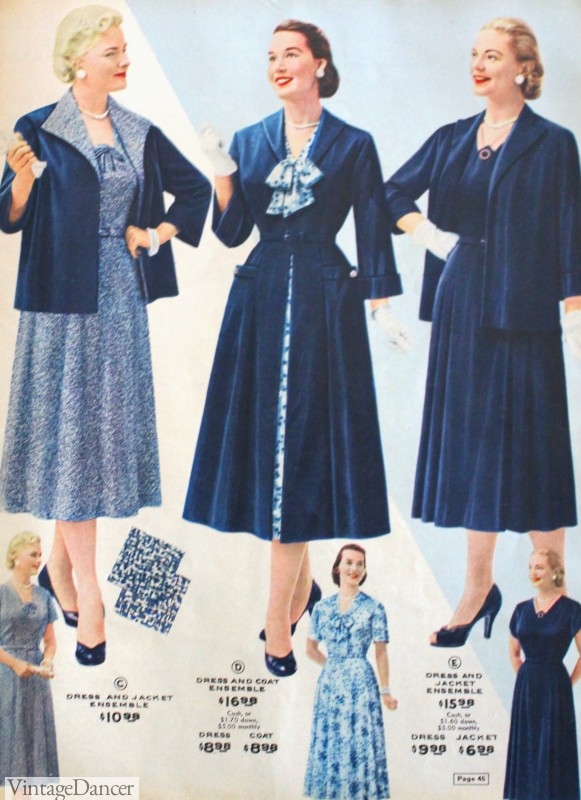
Fall dresses and coats
Correct textures are her greatest aid in keeping down the impression of bulk and expansiveness. Shiny surfaces will catch the light and be reflected in rounded folds; dull, broken-surfaced fabrics such as heavy crepes will absorb the light and make shadows which reduce apparent size. Bulky fabrics will make her appear massive; rich-napped and pile fabrics add inches through their thickness and rounded folds.
Clinging jerseys tend to be too figure-revealing. In other words, this type of person needs lightweight tweeds and sheer woolens, pliable worsted’s, heavy silk or wool crepes, semi-sheers, and prints in large, vague designs. Like the short/stout person, she should wear nothing stiff, crisp, bulky, or clinging. (Avoid satin dresses and light, airy materials like chiffon. Solid cottons or large print polka dots are best.)
Shop 1950s Plus Size Fashion Dresses
Debbie Sessions has been teaching fashion history and helping people dress for vintage themed events since 2009. She has turned a hobby into VintageDancer.com with hundreds of well researched articles and hand picked links to vintage inspired clothing online. She aims to make dressing accurately (or not) an affordable option for all. Oh, and she dances too.
